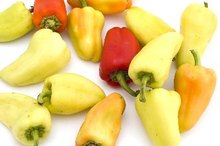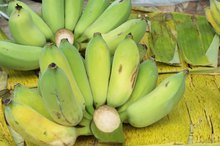Differences Between Cayenne Pepper & Jalapeno
The pepper family tree has five branches and cayenne, jalapeno and sweet bell peppers all belong to the same species, capsicum annum. Native to South and Central America, chilies are one of the world's oldest crops, cultivated for as long as 10,000 years. In addition to being packed with nutritional goodness, chilies are believed to have a wide range of medicinal properties. Capsaicin, the alkaloid compound that gives the vegetables their heat, is said to stimulate the brain's production of natural opiates.
The History of Chili Peppers
Christopher Columbus's assumption that he'd found a shortcut to India when he reached the Americas resulted in two enduring misnomers: aboriginal people being called "Indians" and chilies being called "peppers." Columbus first sampled the fiery little pods in Haiti on New Year's Day 1493, calling them "pimiento," Spanish for pepper, because the taste reminded him of an unrelated species, the costly black pepper grown in India. The Spanish went wild for them and seafaring Portuguese traders spread the seeds, and the popularity of chilies, all over the world. The people of Asia and Africa took to chilies with such enthusiasm that according to Yale Global Online, by the 19th century, many Europeans believed they were native to India.
- Christopher Columbus's assumption that he'd found a shortcut to India when he reached the Americas resulted in two enduring misnomers: aboriginal people being called "Indians" and chilies being called "peppers."
- The people of Asia and Africa took to chilies with such enthusiasm that according to Yale Global Online, by the 19th century, many Europeans believed they were native to India.
Measuring Heat
Yucca Flower Facts
Learn More
The quantity of capsaicin determines a chili's heat level. In 1912, American chemist Wilbur Scoville devised a test that involved diluting ground chilies with a sugar and water solution until the tongues of testers no longer burned when they tasted it. The higher the number assigned, the hotter the chilies. Even though that process has been replaced by a more technologically advanced one, people still refer to Scoville units as indicators of heat. The world's hottest chili, the Naga Viper, is a hybrid of three extremely hot strains 4. Developed in England but grown in India, it scores an incendiary 1,359,000 on the Scoville scale.
- The quantity of capsaicin determines a chili's heat level.
- Developed in England but grown in India, it scores an incendiary 1,359,000 on the Scoville scale.
Cayenne Peppers
These slender chilies are 3.5 to 8 in. in length and at 30,000 to 50,000 Scoville units, are plenty hot enough for most people's tastes. Small white flowers develop first into glossy green pods but when fully mature, the chilies turn fire-engine red. Like other chilies, capsaicin is concentrated in the internal white membranes, called the placenta, and the seeds, which are often dried and marketed as red pepper flakes. India is the world's largest consumer and exporter of both fresh and dried cayenne. As the cheapest and most plentiful chili available in Indian markets, cayennes are used for everyday cooking.
- These slender chilies are 3.5 to 8 in.
- Like other chilies, capsaicin is concentrated in the internal white membranes, called the placenta, and the seeds, which are often dried and marketed as red pepper flakes.
Jalapeno Peppers
Foods Containing Capsaicin
Learn More
Jalapenos, the chili of preference for Mexican food, are named for the city of Xalapa in Veracruz. Shorter and plumper than cayennes, jalapenos are also much lower on the Scoville scale, with a range of 2,500 to 8,000 units. Even though cayennes have a much greater Scoville span, in taste terms, they'd always be described as "hot" or its superlatives. By contrast, jalapenos range from quite mild to rather hot -- and you can't tell which is which just by looking at them. According to Jalapeno Madness, some chefs claim that the presence of "corking," thin lines that resemble veins, may indicate pungency but admit that this detection method isn't foolproof.
- Jalapenos, the chili of preference for Mexican food, are named for the city of Xalapa in Veracruz.
- Shorter and plumper than cayennes, jalapenos are also much lower on the Scoville scale, with a range of 2,500 to 8,000 units.
Related Articles
References
- Texas A & M University; Aggie Horticulture; Pepper
- Jalapeno Madness: Frequently Asked Questions About Jalapeno Peppers
- Nutrition-And-You.Com: Cayenne Pepper Nutrition Facts
- The Hot Word Dictionary; "Meet the New Hottest Chili Pepper, the Naga Viper"; Dec. 4, 2010
- Fox News Alternative Medicine; "Hot Chili History"; Chris Kilham; Sept. 1, 2010









